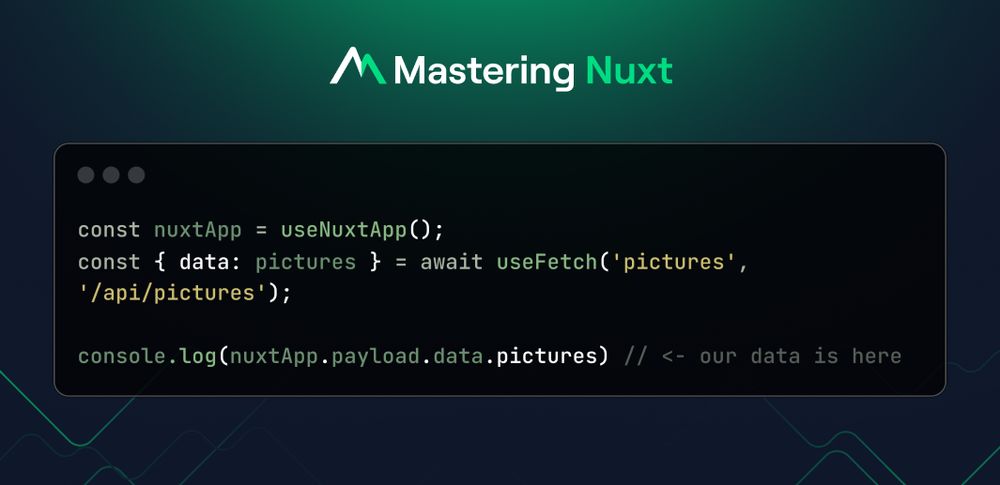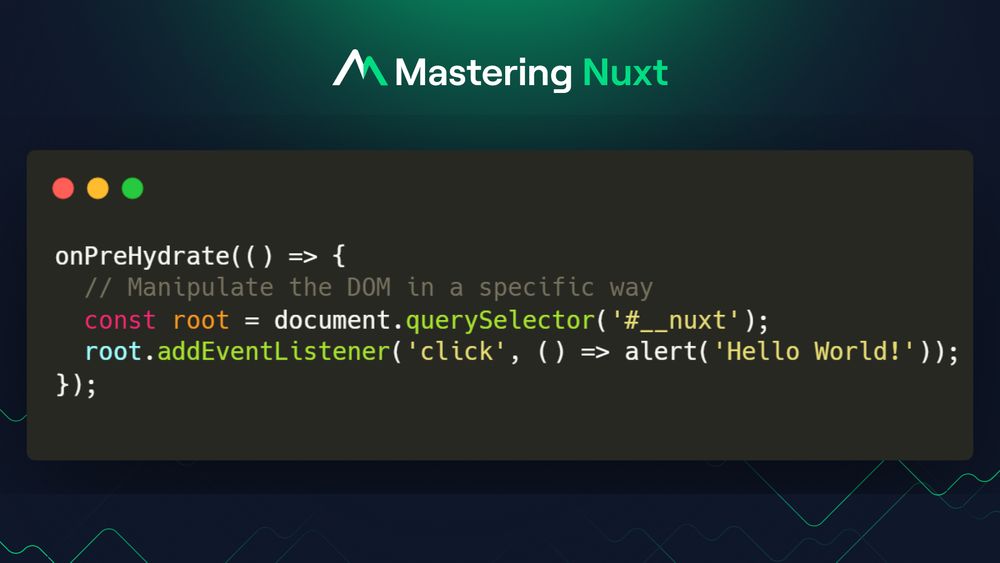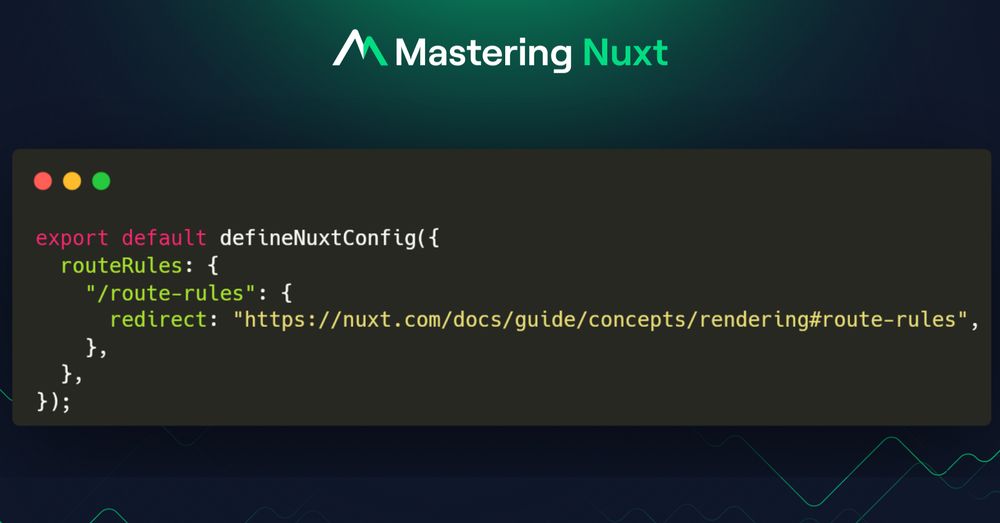
Courses developed in collaboration with @nuxt.com
Powered by @bitterbrains.com

This isn’t just "another" course. It’s your hands-on guide to mastering full-stack Nuxt dev by building a production-ready AI chat app from scratch.
Get it now 👇
The Black Friday Early Bird Deal is LIVE: up to 60% OFF @vuejs.org, @nuxt.com, React, Angular, & JavaScript Certification + get bonus items with Mid or Senior Certification🎁
Don’t miss our biggest deal ever👇
go.certificates.dev/eb25X

The Black Friday Early Bird Deal is LIVE: up to 60% OFF @vuejs.org, @nuxt.com, React, Angular, & JavaScript Certification + get bonus items with Mid or Senior Certification🎁
Don’t miss our biggest deal ever👇
go.certificates.dev/eb25X
When you want to create a redirect in a server route, Nuxt lets you use the `sendRedirect` method from h3.
By default, this sends a 302 (temporary) redirect, but you can specify a different status code if needed.

When you want to create a redirect in a server route, Nuxt lets you use the `sendRedirect` method from h3.
By default, this sends a 302 (temporary) redirect, but you can specify a different status code if needed.
Learn how `useState` keeps your app reactive, SSR-ready, and perfectly simple - no complex setup, no data leaks, just clean global state that works.
https://masteringnuxt.com/blog/understanding-usestate-in-nuxt-the-simple-way-to-share-state

Learn how `useState` keeps your app reactive, SSR-ready, and perfectly simple - no complex setup, no data leaks, just clean global state that works.
https://masteringnuxt.com/blog/understanding-usestate-in-nuxt-the-simple-way-to-share-state
With Nuxt, since version 3.9, you can control how fetch requests are deduplicated using the dedupe parameter in the useFetch composable.
By setting dedupe to 'cancel', the previous request is cancelled and a new one is made whenever parameters change.

With Nuxt, since version 3.9, you can control how fetch requests are deduplicated using the dedupe parameter in the useFetch composable.
By setting dedupe to 'cancel', the previous request is cancelled and a new one is made whenever parameters change.
With Nuxt, you can access the entire payload sent from the server to the client using the useNuxtApp composable.
This allows you to inspect all the data and state transferred during SSR or hydration.

With Nuxt, you can access the entire payload sent from the server to the client using the useNuxtApp composable.
This allows you to inspect all the data and state transferred during SSR or hydration.
This allows you to inspect all the data and state transferred during SSR or hydration.

This allows you to inspect all the data and state transferred during SSR or hydration.
When working with Nuxt, you can control where your code runs by checking the environment. Use if (!import.meta.server) to skip code on the server, and if (!import.meta.client) to skip code on the client.

When working with Nuxt, you can control where your code runs by checking the environment. Use if (!import.meta.server) to skip code on the server, and if (!import.meta.client) to skip code on the client.
Join Evan You, Daniel Roe, Anthony Fu, and more for two days of deep Vite talks, workshops, and the latest in web tech.
See how Vite is powering Nuxt and shaping the future of web development.
🎟️ Info & Tickets here: https://viteconf.amsterdam/

Join Evan You, Daniel Roe, Anthony Fu, and more for two days of deep Vite talks, workshops, and the latest in web tech.
See how Vite is powering Nuxt and shaping the future of web development.
🎟️ Info & Tickets here: https://viteconf.amsterdam/
For example, you can name your test file like this 👇

For example, you can name your test file like this 👇
In Nuxt you can pass route objects to `navigateTo`, similar to `router.push` in Vue Router.
This enables navigation using named routes, query parameters, or hash fragments.

In Nuxt you can pass route objects to `navigateTo`, similar to `router.push` in Vue Router.
This enables navigation using named routes, query parameters, or hash fragments.
To do this, wrap your component with a `<DevOnly>` tag in your layout file. This component will be excluded from your production build.

To do this, wrap your component with a `<DevOnly>` tag in your layout file. This component will be excluded from your production build.
This lets you manipulate the DOM or add event listeners using only vanilla JavaScript:

This lets you manipulate the DOM or add event listeners using only vanilla JavaScript:

We can do that with useRequestHeaders (or useRequestHeader):

We can do that with useRequestHeaders (or useRequestHeader):

Modules can only affect your Nuxt app during build time.
But we can use methods from @nuxt/kit to do things that influence the runtime behaviour:

Modules can only affect your Nuxt app during build time.
But we can use methods from @nuxt/kit to do things that influence the runtime behaviour:
We should wrap it around distinct chunks of functionality where you can handle a group of potential errors together:
- `NuxtPage` components that represent nested routes
- Widgets on a dashboard
- Modals
We should wrap it around distinct chunks of functionality where you can handle a group of potential errors together:
- `NuxtPage` components that represent nested routes
- Widgets on a dashboard
- Modals
You can define a redirect for any route, and by default, it uses a temporary 307 status code. This is the simplest & most efficient way to handle basic redirects.

You can define a redirect for any route, and by default, it uses a temporary 307 status code. This is the simplest & most efficient way to handle basic redirects.
By Michael Thiessen.
https://masteringnuxt.com/blog/how-nuxterrorboundary-works

By Michael Thiessen.
https://masteringnuxt.com/blog/how-nuxterrorboundary-works
You can specify this class using the `prefetched-class` prop, which helps you visually identify prefetched links during development.

You can specify this class using the `prefetched-class` prop, which helps you visually identify prefetched links during development.
In Nuxt, you can validate the request body before using it by leveraging readValidatedBody from h3. Provide a validation function to ensure the body meets your requirements.

In Nuxt, you can validate the request body before using it by leveraging readValidatedBody from h3. Provide a validation function to ensure the body meets your requirements.
In Nuxt, you can check for specific error codes like 404 using the statusCode property from the useError composable. This lets you show a custom message for not found pages, while handling other errors differently.

In Nuxt, you can check for specific error codes like 404 using the statusCode property from the useError composable. This lets you show a custom message for not found pages, while handling other errors differently.
This is useful for testing route-specific content or behavior in your Nuxt application.

This is useful for testing route-specific content or behavior in your Nuxt application.

